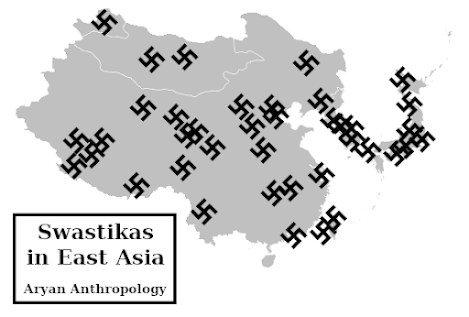This is the fourth article in our series of posts examining the use of the swastika worldwide.
Right-facing, left-facing, and rotated swastikas have been used in China since the beginning of the Bronze Age in the Majiayao culture (~2700-2350 BC). It is unclear if other Chinese cultures began using the swastika or if Bronze Age swastika use died out with the Majiayao. By the early Iron Age (~1000-700 BC) swastikas appear in southwestern Tibet. These swastikas became a holy symbol in the Bon religion of Tibet, which remains an important religion to this day.
By the 1st century AD Buddhism arrived in China, and over the next few hundred years the religion grew in popularity and spread to Korea, Japan, and Tibet. With the spread of Buddhism, we find the spread of the swastika. Due to the swastika's long history in China, it's been adapted to various local forms and has become used as a symbol in other religions originating in China.
In Japan, the swastika was used as an emblem for various clans and cities. In the 21st century, the Japanese word for swastika, "manji", has become a youth slang with various meanings.
In Mongolia, Buddhism became the state religion during the Yuan dynasty, leading to the swastika becoming incorporated into state emblems of Mongolia. Even to this day, some Mongolian state emblems use the swastika.
Despite over 4000 years of swastika use in "East Asia", prejudiced Westerners have demanded billions of people stop using the swastika... Just a few years ago a Mongolian musician was beaten nearly to death for using a swastika. This prejudice will never end unless we continue researching the long history of the swastika.
Read the full article here:
https://aryan-anthropology.blogspot.com/p/swastikas-in-east-asia.html
***
To see the other articles in our series on the swastika, click here:
https://aryan-anthropology.blogspot.com/p/the-swastika-aryan-symbol.html

No comments:
Post a Comment